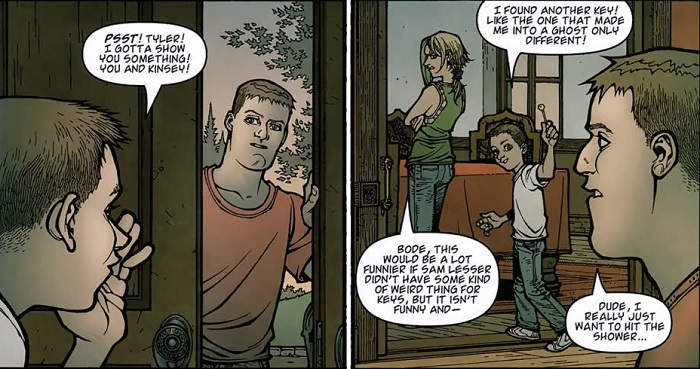It’s nearly Halloween, which means it’s time once again for my annual Joe Hill re-read. Since all of my copies of NOS4A2 and Horns are currently being read by friends and relations, I decided to take a re-gander at Locke & Key, Hill’s epic graphic novel about a family besieged by evils, human and demon alike. As all good horror stories are, it’s a densely woven tale spanning centuries with an unlikely band of heroes up against the ultimate Big Bad, a creature with endless patience and a zeal for violence, chaos, and corruption.
Origin Story
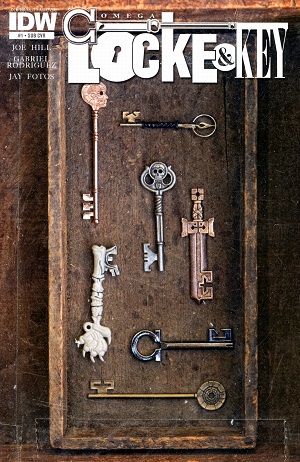 After their father is murdered by a pair of bloodthirsty high school students, the Locke family relocates from San Francisco to Keyhouse in Lovecraft, MA. The estate has been passed down through the Lockes since the Revolution, but the secrets it holds aren’t just familial. Magic keys created by previous inhabitants are scattered throughout the compound and hexed to be found only by children with moral intentions. Bode quickly collects a treasure trove of keys – one turns the user into a ghost, another allows the user to switch genders, yet another opens the user’s head so ideas can be added or removed, and others that turn the user into the ruler of a squirrel army, a giant, or an animal – but it’s the key to the wellhouse that causes the most trouble. It summons an echo or memory of a person, in this case a sinister being with a legion of names, none of them good. Once it becomes corporeal it enacts a centuries-old plot to conquer the world, one key and one soul at a time, but first it has some fun destroying the Lockes and Lovecraft-ites piece by bloody piece.
After their father is murdered by a pair of bloodthirsty high school students, the Locke family relocates from San Francisco to Keyhouse in Lovecraft, MA. The estate has been passed down through the Lockes since the Revolution, but the secrets it holds aren’t just familial. Magic keys created by previous inhabitants are scattered throughout the compound and hexed to be found only by children with moral intentions. Bode quickly collects a treasure trove of keys – one turns the user into a ghost, another allows the user to switch genders, yet another opens the user’s head so ideas can be added or removed, and others that turn the user into the ruler of a squirrel army, a giant, or an animal – but it’s the key to the wellhouse that causes the most trouble. It summons an echo or memory of a person, in this case a sinister being with a legion of names, none of them good. Once it becomes corporeal it enacts a centuries-old plot to conquer the world, one key and one soul at a time, but first it has some fun destroying the Lockes and Lovecraft-ites piece by bloody piece.
Joe Hill wrote all 36 issues, compiled into six volumes, for IDW Publishing from 2008-2013. All interior art was done by Gabriel Rodriguez. They were assisted by colorist Jay Fotos and letterer Robbie Robbins – aka the exec VP and co-owner of IDW. Each hardcover volume comes with architectural designs of parts of the house (Rodriguez is an architect in his day job), and Subterranean Press has produced some gorgeous limited editions including scripts. There’s a fabled volume 7, “The Golden Age,” containing two one-shots and four other tales, but no word yet on a release date. Attempts were made to translate the series to the silver screen and small screen, but both failed. A star-studded audiobook was also recently released. Not too long ago, Tor.com hosted a re-read of the series, so check it out when you finish the series.
Trigger warnings abound for offensive names (regarding race, homosexuality, and people with intellectual disabilities) and sexual assault/rape (off-camera). I usually steer clear of stories with rape plots and derogatory name-calling, but Hill makes sure neither are gratuitous. Moreover, the rape is all about the victim, never the rapist; it’s used to affect her character development, not to motivate the men around her. Basically, although those situations are hard to sit through, but they are used to make very specific points and are necessarily to tell the full arc. I wouldn’t disregard this series over them, but be prepared for an onslaught.
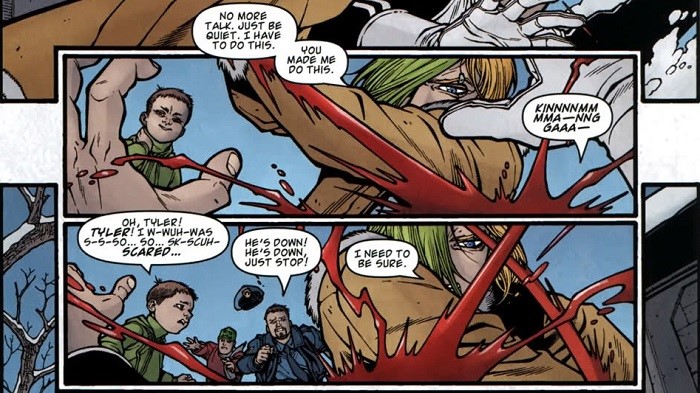
To Pull or Not To Pull
Like some of the best horror fiction, Locke & Key is about family, how we hurt the ones we love and love the ones who hurt us. No matter how much we may clash with each other, we come together to fight when the family is threatened. Bode discovers the strength of a unified family outside his own as he joins a flock of sparrows in battling a pack of demon-influenced dogs. Ty and Kinsey already know how important fighting to protect their family is, but struggle with how to function when not at war. Nina has the worst of it. It’s not that family isn’t enough to keep her sober, but that the strain of having to lead while fundamentally unable to do so has the family unit cracking under the pressure.
Sometimes a family is tied together through a blood bond, other times that unity is forged through similar experiences and a desire to connect with another person. You can’t choose your family and you can at the same time. Rufus filters his experiences through a military game where his mother is the unit captain, he’s her brave soldier, and those who would stop him from saving his friends – his adoptive family – are the enemy. Kinsey and Tyler find family outside their own in their high school friends and lovers. Bode builds a tentative family with Rufus, and Uncle Duncan reunites with his distant relations. The real evil of the piece isn’t just an interdimensional demon but a threat to the very notion of family. It had a family, but there was no kindness or caring in its world, just death. Family, to the demon is Rufus’ interpretation made literal and absent love: family “is the final, most elemental unit of power. A small group helplessly bound together by blood with a shared set of skills and tools for consolidating power and subjugating others.”
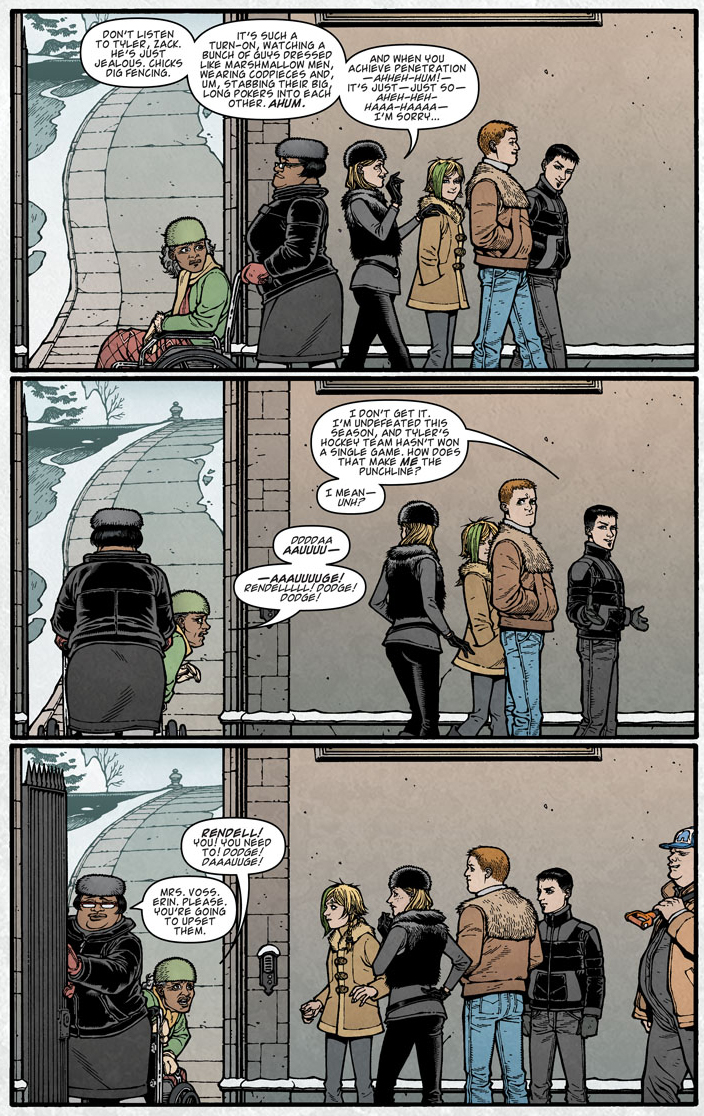
The series isn’t just about how a family works together, but what happens when one falls apart. The story opens in 2008 with the Locke children and begins in the 1700s when Benjamin Locke makes the first key, but it really starts with Rendell and Duncan (Ty, Kinsey, and Bode’s father and uncle, respectively), Erin, Dodge, Ellie, Mark, and Kim in the 1980s. Theirs was a family built on flighty teenage romance and selfish impulsiveness. Adding powerful magic to the mix brought the whole thing crumbling down and cost several lives in the process. The Locke children survive as long as they do only because of the solidity of their own family and friends, and suffer when those bonds are tested to the brink. Love may conquer all, but that doesn’t guarantee survival.
Locke & Key is dark and perverse, but always on point. You feel a connection with the characters, like they’re practically crawling out of the pages. Much of that is thanks to Rodriguez’s evocative and expressive artwork. The full and splash pages in particular – especially the ones where the Head Key and Shadow Key are involved – are fantastic. He wastes no space but the panels never feel cluttered or crowded. Details pile on, so much so that even though I’ve read the series a few times I still caught new bits this time around. The landscape is so textured you can almost feel the roughness of the cave stones and the softness of Kinsey’s wings. It pairs wonderfully with Joe Hill’s haunting script.
Hill is masterful at suggesting just enough that the reader’s imagination fills in the blanks with more terror than any writer could create. Rodriguez often shows the moment just before or just after an especially violent act or focuses the art on the perpetrator, a wonderful conversion of Hill’s tactics. Jay Fotos does stellar work. His color palette reminds me a bit of The Shining, all vibrant hues that contrasts beautifully with the darkness of the story. Robbie Robbins’ lettering is the perfect icing on a fabulous cake. And just wait until you get to Bill Watterson’s perfectly delightful take on the life and times of Bode.
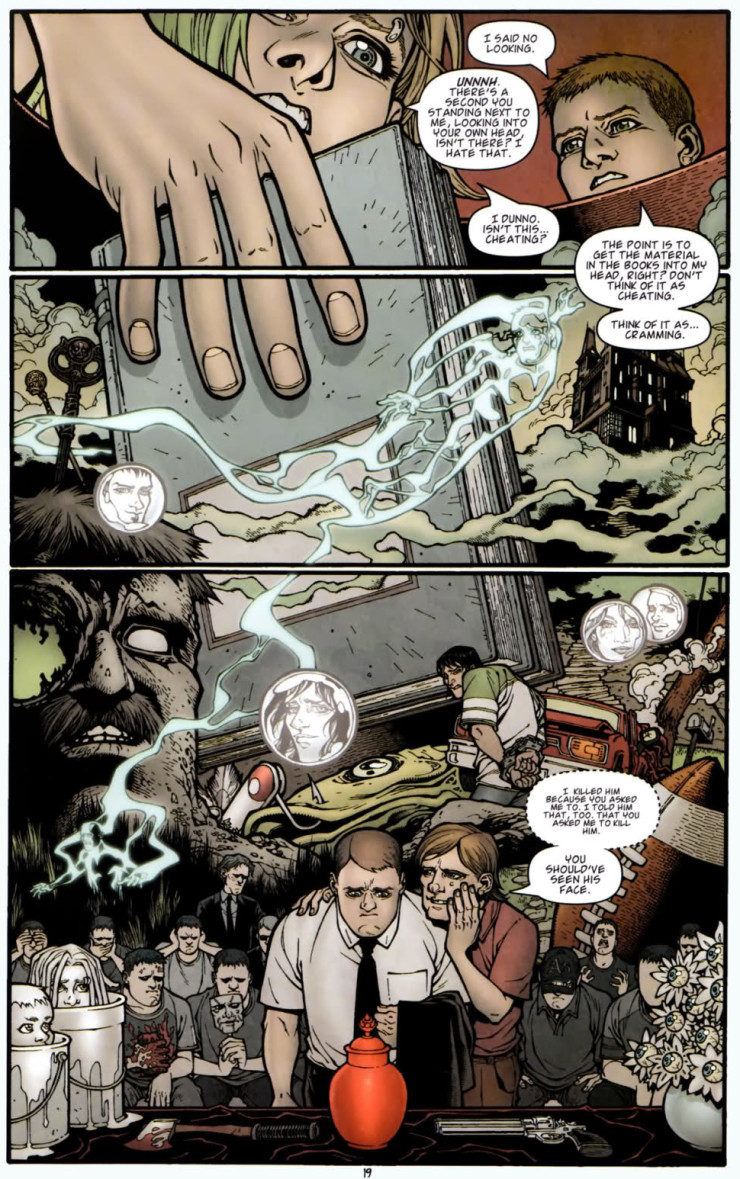
Horror works best when it’s more than just frights. Yes, torture porn is scary, but take away the graphic violence and all you’re left with are a bunch of hot young adults making stupid decisions. There needs to be a plot and well-developed characters underneath the blood, all of which Locke & Key has in spades. If you’ve never read Joe Hill before, this is a good place to start (next, of course, you’ll want to read Horns…and then maybe The Cape or 20th Century Ghosts). Hill is a master at pushing the reader into uncomfortable situations and leaving them there, letting the suspense and tension percolate into dread until your heart is pounding and you can’t put the damn book down.
He writes horror that’s not just characters being terrified of being tortured to death by a sociopath, but of them coming to terms with all the awful things they’ll have to endure and inflict before darkness finally takes them. As evil bubbles to the surface in Lokce & Key, Kinsey must come to terms with her feelings of helplessness and loss, Tyler with his guilt over his inadvertent role in his father’s death, Bode with his reckless precociousness, and their mother Nina with her depression and alcoholism. All the while, the creature wearing a teenage meat suit manipulates, enslaves, and destroys, both for pleasure and plan. The kids are the stars, but this is by no means a YA story.
This is one of those series that every serious comic book reader needs to have in their collection. I also highly recommend reading each volume with a bit of a break in between to really let the story set, so to speak. It’s tempting to want to plow all the way through, but horror stories work best with building tension. And you’re definitely going to want some space between all the backstory plot work in “Clockworks” and the frightful pandemonium of “Alpha & Omega.” If you didn’t have plans on Halloween, you do now. Trust me, you’ll thank me when it’s all said and done.
Alex Brown is an archivist, research librarian, writer, geeknerdloserweirdo, and all-around pop culture obsessive who watches entirely too much TV. Keep up with her every move on Twitter and Instagram, or get lost in the rabbit warren of ships and fandoms on her Tumblr.










